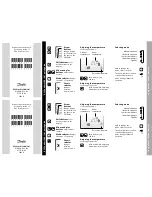
ControlWave Instruction Manual (CI-ControlWave)
2-28 Installation
Revised
Nov-2010
Pin
RS-485
Signal
RS-485 Description
3
RXD-
Receive Data – Input
4
5
TXD-
Transmit Data – Output
6
7
TXD+
Transmit Data + Output
8 ISOGND
Isolated
Ground
Table 2-11. RS-485 COM4 Port (Male DB9) Connector Pin Assignment
Pin
RS-485
Signal
RS-485 Description
1
2
RXD-
Receive Data - Input
3
TXD-
Transmit Data - Output
4
TXD+
Transmit Data + Output
5 ISOGND
Isolated
Ground
6
RXD+
Receive Data + Input
7
8
9
Since the RS-485 port is intended for network communications, refer to
Table 2-12
for the appropriate connections for wiring the master, first
slave, and
nth
slave.
Essentially, the master and the first slave transmit and receive data on
opposite lines; all slaves (from the first to the
nth
) are paralleled (daisy-
chained) across the same lines. Wire the master node to one end of the
RS-485 cable run using a 24-gauge paired conductor cable (such as a
Belden 9843).
Note
:
ControlWave
only
supports half-duplex RS-485 networks.
Table 2-12. RS-485 Network Connections
From Master
To First Slave
To nth Slave
TXD+ RXD+ RXD+
TXD–
RXD–
RXD–
RXD+ TXD+ TXD+
RXD– TXD– TXD–
ISOGND ISOGND ISOGND
















































